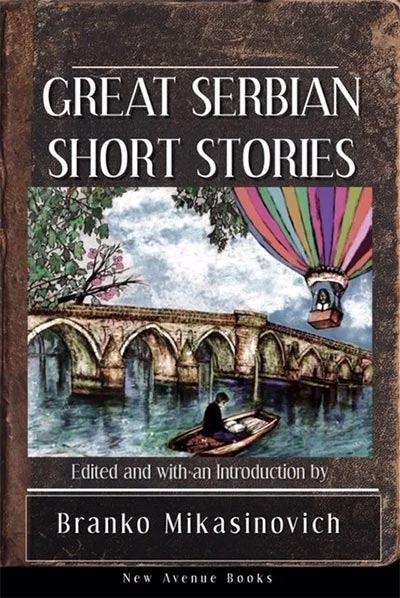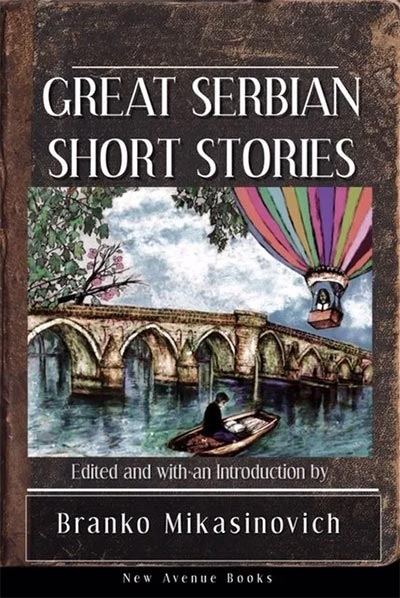“But the country could not accept the bridge and the bridge could not accept the country.”
This quotation, from the short story “The Bridge on the Žepa,” by the 1961 Nobel laureate Ivo Andrić, whose story, “Thirst,” is included in this collection, reflects the essence of the state of human relations in the Balkans. Here Andrić observes that while bridges are built to connect and not divide, human nature, as it is, can lead to discord and alienation. In fact, throughout its history Serbia was a point of convergence, and even more often, a place of confrontation.
The stories in this anthology depict figuratively the banks on either side of the bridge in Serbia and the Balkans. On the one side there is respectfulness and coalescence, and on the other, turbulence and division among people along social, economic, ethnic, and religious lines. One of the best ways to get acquainted with foreign literature is to select an anthology in order to sample individual writers to get a sense of a nation’s literary culture. To that end, the purpose of this anthology of short stories is to enlighten the reader about Serbia and the Serbian people. This volume represents the quintessential anthology of Serbian short stories in the English language selected in terms of the diversity of topics, styles, and literary trends, covering both the nineteenth and twentieth centuries. The stories chosen for this anthology represent the best available selection presenting unique tales indigenous to Serbia.
The nineteenth-century stories deal with life in rural Serbia,
characterized by realistic descriptions, simplicity, and appealing characters. In contrast, Serbia’s twentieth-century authors are recognized for their courage and daring in confronting totalitarian communist norms, and later for literary innovations illustrating the environment, people, and values of democratic Serbia. These Serb writers rank among the masters of modern literature.
The first short stories appearing in Serbia of literary value date from the middle of the nineteenth century. During that period, the Serbian literary milieu was impacted significantly by Western European and Russian cultures, due mostly to two developments: firstly, a number of Serbian students acquired higher education in Western European countries, and upon returning, exerted their influence on the Serbian literary scene, bringing with them new and progressive ideas. Through the influx of such foreign-educated Serb intellectuals, Serbia was able to establish at least a peripheral literary connection with Western Europe. Secondly, Russian literature of the nineteenth century with its two literary giants, Leo Tolstoy and Fedor Dostoyevsky, were accessible to Serbian intellectuals because of the similarity of the Serbian and Russian languages and the ability of Serbs to read some of the works in the original, as well as in translation. Other Russian authors, such as Ivan Turgenev and Anton Chekhov were not only popular but also influential. Turgenev, for example, was known for his writings about Russian peasantry, which inspired Serbian authors to write about rural society and the problems it faced accommodating to a changing world. On the other hand, Chekhov’s plays and short stories were greatly admired in Serbia and served as a model for them.
However, even at that time, Eastern European literature, with its ethnic and cultural diversity, was by some considered a vehicle for connecting Western Europe with Europe’s East and beyond. This trend, in establishing a new East-West literary connection, became even more pronounced in the second half of the twentieth century. A case in point being the eminent Serbian writer Milorad Pavić
with his great popularity, not only in Russia, but in China and Japan. As with Milorad Pavić’s “Glass Snail,” some of the twentieth-century stories in this collection, being complex masterpieces, also merit re-reading because of different possible interpretations and interwoven themes. These include Aleksandar Tišma’s “The World’s Top Expert,” and Milovan Vitezović’s “Sacred Love,” as well as some others.
Initially Serbian short stories focused on the Serbs’ traditional patriarchal way of life. These stories belonged to the literary school of “Realism,” containing genuine, often sad elements whose main characters possessed an abundance of strong emotions, both positive and negative. The positive emotions of passionate love, courage, and sacrifice conflicted with negative feelings of unhappiness, shame, and jealousy.
It is often said that the greatest predicament facing Serbia was its strategic location, being at the crossroads between East and West. Its geographic position forced it to endure the tenacious impact of three competing civilizations: Western Europe, the Russian Empire, and Ottoman Turkey. The Western European predominance was due to a large Serbian presence in the populations of the Military Frontier. This region of the former Austro-Hungarian Empire was on the northern border of the Kingdom of Serbia and those Serbs there were exposed to Western values, literature, and culture. The Russian influence was the result of the shared Slavic linguistic and Orthodox religious bonds expressed in the spiritual, educational, and religious spheres. Lastly, the Ottoman Empire left an indelible impact after four centuries of oppressive Turkish occupation of much of the territory of modern Serbia. While European and Russian influences were mostly cultural, educational, and literary, the remnants of the long Turkish presence were manifested in Serbia’s cultural heritage, architecture, and customs.
One of the first writers of Serbian Realism was Stjepan Mitrov Ljubiša. According to literary historian, Jovan Deretić (1934-
2002), Mitrov Ljubiša was called “the Njegoš of prose,” because of the resemblance in his writings to that of the great Serbian poet, Prince Bishop Petar Petrović-Njegoš (1813-1851). Mitrov Ljubiša frequently rendered the national historical background and significant personalities from his region of Peštrovići, the southern part of Montenegro, using local forms of oral tradition and expressiveness, as in his famous story “Kanjoš Macedonović.”
In the second half of the nineteenth century, a unique literary development occurred. A significant number of writers focused on the place and treatment of women in a strictly patriarchal society such as Serbia was at that time. Milovan Glišić emphasized the pivotal role of women in rural society due to the frequent loss of their husbands in regional wars, which required them to assume what were customarily male duties in addition to running the household and bringing up their children. Lazar (Laza) Lazarević, in his story “The First Matins with My Father,” described the father of the boy, the main character, as a cold and dominating personality, while the boy’s mother appears as intellectually and morally superior to her husband. Svetozar Ćorović illustrates in his short story, “Hodja Saleek,” the power of a woman portrayed through her beauty and self-confidence, while Borisav Stanković’s story, “In the Night,” presents the ill-treatment of women in a society strongly affected by old customs and traditions, as they existed in villages or small agrarian communities.
The development of the Serbian short story in the twentieth century can be divided, roughly speaking, into three periods. The first period spanned from the early nineteen hundreds to the end of the Second World War (1900-1945). The second period is from the end of the war in 1945 to 1980, the year in which Communist dictator, Josip Broz Tito, died. The third period lasted from Tito’s death in 1980 up to the overthrow of the rule of Slobodan Milošević during the “October revolt” in 2003.
Serbia’s literary activity at the beginning of the first half of the twentieth century was interrupted by the First World War (1914-
1918). This period was dominated by new trends known as “Moderna,” marked by the vague influence of a variety of Western European literary movements, more so among Serbian poets than prose writers.
The second period after 1944 originated with the introduction of Communist rule under Josef Broz “Tito” (1892-1980) accompanied by the initiation of strict political and artistic limitations, akin to Joseph Stalin’s (1878-1953) totalitarian policies. In the Soviet Union and other communist countries, including Yugoslavia, officially promoted literature was known as “proletarian literature,” later defined as “Socialist Realism.” The main topics of this literary direction were the industrial and agricultural transformation of the country and the creation of a new man and woman with ideal personal qualities and dedication to the Communist cause. After 1970, with an era of somewhat loosened communist restrictions, Serbian writers returned to the themes of human destiny, spirituality, and also diversity.
Among the significant writers of the Communist period were Branko Ćopić and Dobrica Ćosić. Ćopić’s “Cruel Heart” displays a peasant partisan, who, behind his harsh rhetoric, hides his loving and caring feelings for his mother. Ćosić’s“Ashes” presents a gloomy picture of loneliness and inevitable collapse. Both Ćopić and Ćosić were partisan fighters and ardent communists in the early stages of their lives. Both gradually became disillusioned with Communist ideology, and, as a result, Ćopić committed suicide, while Ćosić became one of the leading political dissidents. Upon Tito’s death, Yugoslavia disintegrated into seven separate states with the populations enduring ethnic divisions and a civil war. That war, which gradually engulfed most of the republics of former Yugoslavia, lasted from 1991-2001. Literature during the war period centered mainly on issues linked to the conflict, but also addressed a variety of other topics. The new wave of writers embraced original and traditional values, responding to the general
public’s literary preference.
The authors’ writings during this third period of the twentieth century demonstrated an exceptional thematic and stylistic diversity that struck a chord with readers. Evidence of this can be found in the large number of Serbian authors that were translated into English and other languages, reaching a very wide audience. The positive reception of the Serbian and international reading public reflects the strong creative impulses that came out of Serbia at that time and still resonates strongly today.
During the Yugoslav civil wars in the 1990s, stories linked to war and conflict again emerged and became prevalent, as in “The Story about the Bash” by Miroslav Josić Višnjić. This story depicts the ultimate in human suffering during wartime. Postwar consequences, as another example, are detailed in Aleksandar Gatalica’s “Self Portraits,” embodying the tortured life of an immigrant. During this period writers tried to make sense of the events of the war by contributing to a better understanding of relations among the various ethnic and religious groups. Works of post-conflict literature also offered insight into what the issues were and justifications or regrets about the conflicts, reflecting on all the destruction and misery. The perspective of the ordinary citizen also gives these stories an ironic tone, as characters struggle against the overpowering wheels of fate.
A subsequent development was the surge of Serbian women writers in the final years of the twentieth century, emerging as a powerful voice of Serbian literature. These women were writers of novels, plays, satires, poetry, and some short stories, as represented here by Ivana Dimić’s “Christmas Wishes.”
In spite of the wars and resulting devastation, Serbian writers’ predominant interests were contemporary, utilizing authentic themes which brought them recognition and praise.
Branko Mikasinovich




